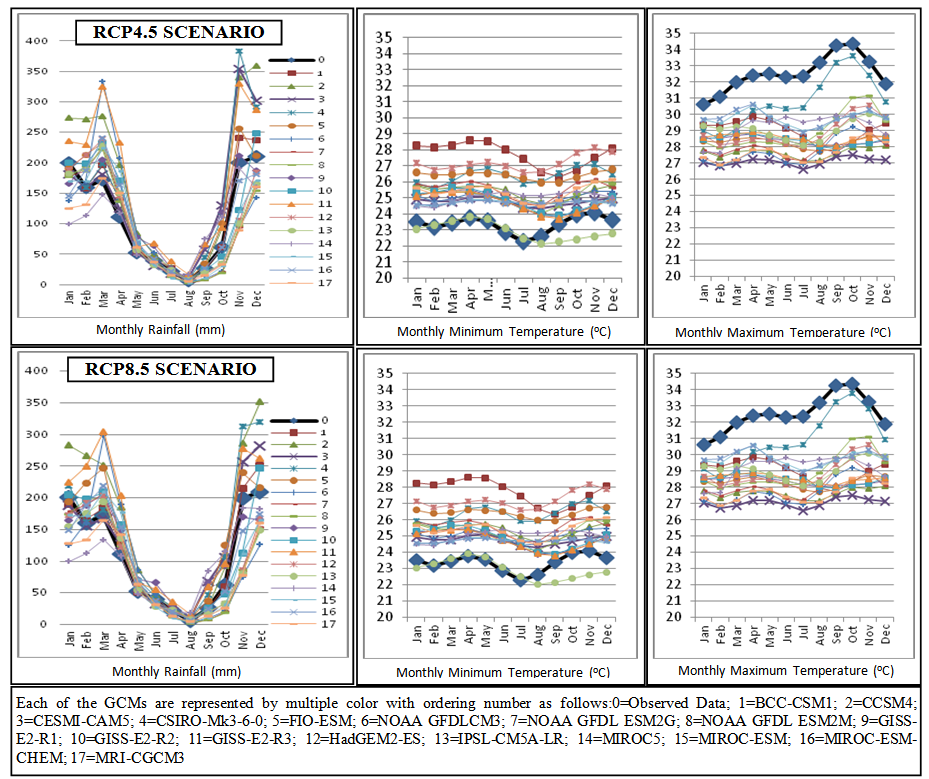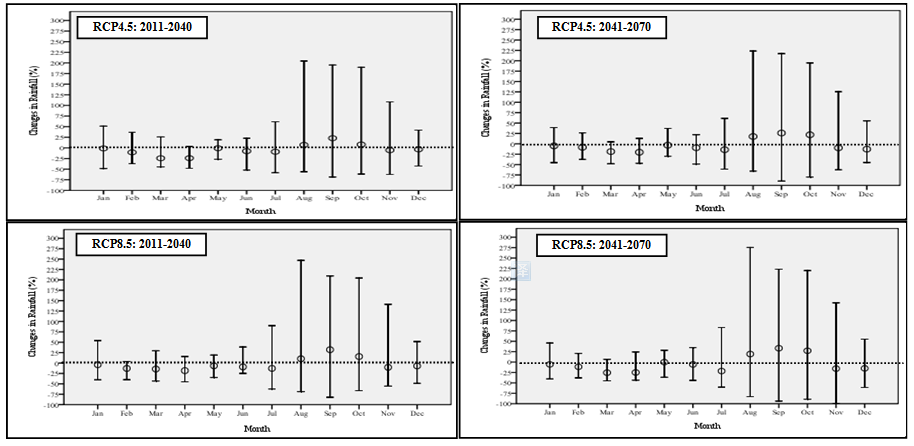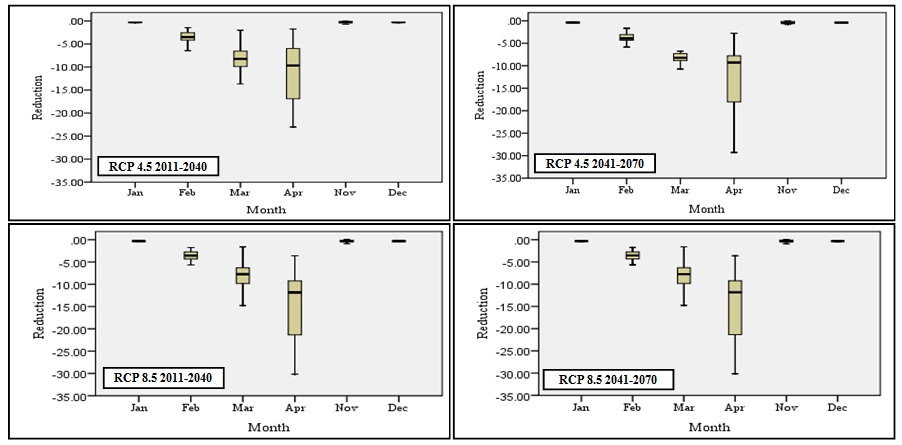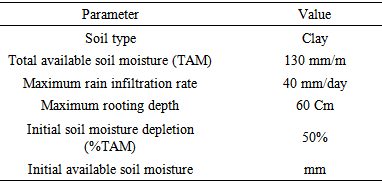-
Paper Information
- Previous Paper
- Paper Submission
-
Journal Information
- About This Journal
- Editorial Board
- Current Issue
- Archive
- Author Guidelines
- Contact Us
International Journal of Ecosystem
p-ISSN: 2165-8889 e-ISSN: 2165-8919
2014; 4(5): 212-223
doi:10.5923/j.ije.20140405.02
Climate Change Impact on Rice Yield and Adaptation Response of Local Farmers in Sumedang District, West Java, Indonesia
A. Candradijaya1, Kusmana C.2, Syaukat Y.3, Syaufina L.2, Faqih A.4
1Doctorate Program, Dept. of Environmental Management, Bogor Agricultural University (IPB)
2Dept. of Silviculture, Kampus IPB Darmaga, Bogor, 16680, Indonesia
3Dept. of Resources and Environmental Economics, Kampus IPB Darmaga, Bogor, 16680, Indonesia
4Dept. of Geophysics and Meteorology, Kampus IPB Darmaga, Bogor, 16680, Indonesia
Correspondence to: A. Candradijaya, Doctorate Program, Dept. of Environmental Management, Bogor Agricultural University (IPB).
| Email: |  |
Copyright © 2014 Scientific & Academic Publishing. All Rights Reserved.
Despite the well-documented model-simulated adverse climate change impact on rice yields reported elsewhere, interventions to address the issue seems still limited, particularly at local level. This links to the uncertainty that entails to climate projection and its likely future impact, which varies across regions and climate models. The study analyzes climate change-induced yield reduction and the adequacy of current adaptations to cope with the large range of impact under various climate models. Seventeen General Circulation Models (GCMs) under Representative Concentration Pathways (RCPs) climate change scenarios of RCP8.5 and RCP4.5, combined with CROPWAT model were used for near-future (2011-2040) and far-future (2041-2070) projections. The output confirms yield reduction to occur in the near-future, to the extent variable across the GCMs. At the highest estimation, rice yield decreases by 32.00% and 31.81%, in comparison to baseline, for near-future under RCP8.5 and RCP4.5, respectively. The reduction extends, with a slightly higher degree, to the far-future. The reduction is sensitive to variation in farming practices of the local farmers, in particular that in planting time and irrigation scheduling. The shifting of planting time to better match rainfall pattern and improved irrigation reduced the yield reduction by 16.16% and 15.18%, respectively. The combined impact of the two, however, still leaves un-tapped a reduction of 5.86%, suggesting that planned interventions are still required to improve the current farm management. The findings provide valuable inputs for relevant authorities to understand the whole continuum of climate change-induced rice yield reduction, based on which sets of planned interventions locally specific for the areas could be developed, accordingly.
Keywords: Climate change, Rice yields reduction, Autonomous adaptation, Planting time, Irrigation
Cite this paper: A. Candradijaya, Kusmana C., Syaukat Y., Syaufina L., Faqih A., Climate Change Impact on Rice Yield and Adaptation Response of Local Farmers in Sumedang District, West Java, Indonesia, International Journal of Ecosystem, Vol. 4 No. 5, 2014, pp. 212-223. doi: 10.5923/j.ije.20140405.02.
Article Outline
1. Introduction
- Most Indonesian population (94%) relies to the greatest extent on rice as their staple food. Taking into account its huge population of 237.64 millions [1], it is understandably that Indonesia cannot rely on the still “thin and volatile” international rice market to fulfill its domestic demand. The Indonesian new Food Law No. 18/2012 explicitly states that food security in Indonesia has to be based on domestic food availability and food sovereignty [2]. In this connection, self-sufficiency on staple food, particularly rice, has been one solution, to which most government programs are directed in order to ensure national food security.In Indonesia, producing more rice for the future is a growing challenge, particularly under the adverse impacts of climate change. According to [3], climate change affects rice yield through movements of climatic variables such as temperature and precipitation. Temperature affects evapotranspiration and determines the length of crop growing season, while rainfall controls irrigation water supply to meet the crop water requirement [4].Studies confirmed that changes in climate have been occurring in Indonesia, to a level substantially variable among regions. Temperature increased at about 0.3℃ over the last decade, and annual precipitation has decreased by 2-3%. The pattern of rainfall has changed. In the southern regions, the rainfall was declined, while in the northern part an increase was observed. A change has also been observed in the seasonality of precipitation, where an increase in the wet-season rainfall was recorded in the southern and a decrease in the dry-season rainfall in the northern region [5, 6]. In terms of future climate projection, it is estimated that warming in Indonesia will occur at a rate highly variable across regions, ranging from the lowest of 1.16℃ to the highest of 1.58℃ until 2070, where the highest temperature potentially occurring in the Island of Kalimantan. In Java, the warming ranges from 1.30℃ in the west part to 1.36℃ in the east [7]. With respect to future projection of rainfall, it is estimated that the trend in future precipitation is highly variable across regions, where majority of Indonesian Island show an increasing trend, while the rest indicates a trend of reduction, particularly in the southern parts. In Java Island, rainfall is estimated to decrease arround 30% until 2080 [8].Efforts have also been made by numbers of studies to quantify the impact of climate change on crop yields. It is reported that a reduction in crop yields will occur in some parts of Asia at a level of 2.5-10% until 2020 and 5-30% until 2050 [9]. Studies in Indonesia estimated that climate change will likely decrease rice yield by 4% per year, soybean by 10%, and maize by 50% [10]. Furthermore, it is reported that until 2050 crop yield reduction will be at a level of 20.3- 27.1% for rice, 13.6% for corn, and 12.4% for soybean [11].Despite the model-simulated adverse impact of climate change on crop yields, farmers are likely still able to survive. This has been made possible by a large number of adaptations in farming management practices assumed to occur autonomously, ranging from simple adjustment on planting calendar to large investment on input and infrastructure. However, the uncertainty that entails to the climate projection and its likely future impact on yields, which varies substantially across crops, regions, and climate models, posted high risks of reduced or inadequate adaptation. This links to the facts that uncertainty in climate change and its likely future impact tend to discourage relevant authorities to develop adequate adaptation measures, particularly those that require substantial investments. In this regards, any climate impact studies should address the potentials of inadequate or reduced adaptation by assuming a wider assumptions or scenarios to capture the whole possible range of climate impacts.This study provides an analysis of rice-yield reduction impact of climate change and the adequacy of the locally-specific farm-level adaptation measures autonomously developed by local farmers to cope with the large range of climate change impact under 17 GCMs using the new climate change scenarios of RCPs used by IPCC in its latest Fifth Assessment Report (IPCC AR5) [12, 13]. In specific, the study aims to analyze (i) the range of changes in climate, specifically for the study area under 17 GCMs, (ii) the extent to which the changes affect rice yield, and (iii) the adequacy of local farmers’ autonomous adaptation, i.e. adjustments in planting time and irrigation schedule, in addressing the current and future impact of climate change.
2. Materials and Methods
2.1. Study Area
- The study was conducted in the Sub-district of Ujungjaya, Sumedang District, the Province of West Java, Indonesia (Figure 1). The location lies approximately between longitudes 107°21' - 108°21' E and latitude 6°44' - 7°83' S. It covers a landmass of 1,518.33 Km2, where agriculture occupies 331.78 Km2 or around 21.85%. According to its water supply, farming is divided into rain-fed (63.17 Km2) whose water supply is exclusively derived from rainfall and irrigated (268.61 Km2) whose water supply is supplemented and/or regulated by irrigation infrastructure [14]. In the study area, however irrigation infrastructure mostly, if not all, has no sufficient capacity to maintain stable water supply for farming all year around. This is because irrigation infrastructure is not equipped with well-constructed water storage facilities to accumulate water from rainfall during rainy season and release it during the dry season. The main variety of rice commonly grown by the local farmers is Ciherang. There are also other rice varieties grown, but still very limited, i.e. Mekongga, Inpari 4, and Inpari 10. The characteristic of those varieties is presented on Table 1.
 | Figure 1. Map of Study Area |
|
 | Figure 2. Planting calendar of irrigated (a) and rain-fed farm (b), in relation to rainfall pattern (c). Source: Annual report of planting area for 2012 [16] |
2.2. Climate Projection
- GCMs were used to project changes in average monthly rainfall and minimum and maximum monthly temperature for two time slices, these are 2011 – 2040 (near-future) and 2041 – 2070 (far-future). Observed climate data for 30 years (1981 – 2010) was collected, as a reference, from local climate station located closest to the study area, that is Jatiwangi Climate Station. The 30 year period was chosen considering that this is the minimum period needed to define a climate. The performance of GCMs was measured by comparing the simulated climate generated by each model with observed climate. It is assumed that those models that generate simulated climate for baseline periode closer to the observed climate will produce more accurate regional climate projection. In this study, seventeen GCMs were used. This is to give an opportunity to generate the potential range of future climate and estimate the possible range of climate change impact on rice yields. The 17 GCMs used is presented on Table 2.
|
2.3. Yield Response
- The extent of climate change impact on rice yield was assessed using CROPWAT 8.0 simulation model developed by FAO [29, 30]. Prior to its application, the CROPWAT 8.0 was calibrated by using local data for climatic condition, crop, soil, and irrigation schedule. The model was then run to simulate the yield response of rice to various GCM models-simulated climatic projections, under different planting times and irrigation schedules. The output of the model gives likely changes in crop yields as a result of changes in minimum and maximum temperature and rainfall.In order to accommodate the local farming practices, the irrigation schedule options of CROPWAT model was set for “rain-fed” and “irrigate at fixed interval per stage”. Based on data collected through interview with local farmers and field observation, the interval of irrigation for different stages of rice development was defined according to different planting times at fixed application depth of 20 mm as presented on Table 3. Adjustments made for crop and soil data are presented on Table 4 and Table 5, respectively.
|
|
|
3. Results and Discussion
3.1. Performance of GCMs
- The annual cycles of average monthly rainfall, and minimum and maximum temperature generated by the 17 GCMs under RCP4.5 and RCP8.5, together with observed data for baseline period are presented on Figure 3. All GCMs under the two scenarios generate seasonal cycles of rainfall that match reasonably well with observed data. However, there appears to be no agreement across the GCMs in simulating rainfall during rainy season (November to April). Some models tend to overestimate the rainfall (CSIRO- Mk3-6-0, CCSM4, CESMI-CAM5 and GISS-E2-R3), while some others generate lower estimation (MRI-CGCM3 and the three variants of NOAA GFDL). The GCM monthly rainfall simulations for rainy season vary substantially with the highest estimation is made by CSIRO-Mk3-6-0 at a level of 383.10 mm in November, and the lowest is recorded at 89.88 mm as estimated by MRI-CGCM3. For dry season, all GCMs generate monthly rainfall estimation relatively close to the observed data. The general pattern indicates that rainfall fluctuates around an average of 50 mm from May to October, with the lowest recorded in August.
 | Figure 3. Comparison of simulated monthly rainfall, and minimum and maximum temperature assessed by 17 GCMs under RCP4.5 and RCP8.5 with observed data for the period of 1981 – 2010 |
3.2. Changes in Rainfall and Temperature
- The projection of rainfall generated by the 17 GCMs for near-future and far-future periods under climate change scenarios of RCP4.5 and RCP8.5 is presented on Figure 4.
 | Figure 4. Changes in monthly precipitation (%) relative to baseline projected by the 17 GCMs under RCP4.5 and RCP8.5 for near-future and far-future periods |
 | Figure 5. Changes in monthly minimum temperature projected by 17 GCMs under RCP4.5 and RCP8.5 for near-future and far-future |
 | Figure 6. Changes in monthly maximum temperature projected by 17 GCM models under RCP4.5 and RCP8.5 for near-future (2011-2040) and far-future (2041-2070) periods |
3.3. Yield Response of Rice to Future Climate
- The yield response of rice to the 17 GCM climate projections is estimated by using a crop simulation model of CROPWAT 8.0 for different planting time and irrigation scheduling under both rain-fed and irrigated rice field. The output of CROPWAT 8.0 is presented on Figure 7 for rain-fed rice and Figure 8 for irrigated rice.
 | Figure 7. Changes in rain-fed rice yield estimated by by 17 GCMs under RCP 4.5 and RCP 8.5 for near-future and far-future |
 | Figure 8. Changes in irrigated rice yield estimated by 17 GCMs under RCP4.5 and RCP8.5 for near-future and far-future |
4. Conclusions
- The results of the study confirm that climate change has been occurring in the study area. Most GCM models show a substantial decrease in annual rainfall for the near- and far-future in comparison to that for the baseline period. However, there is no consistent pattern for the changes in monthly rainfall. The projection is highly variable across the GCM models, but the general tendency shows a decreasing trend in wet-season rainfall and an increasing trend in dry-season rainfall. With regards to projection of temperature, all GCM models are in agreement to show a substantial increase in maximum temperature for the whole months. The general pattern of GCM-model projection for minimum temperature shows a slight decrease for medium-term. However, the level of reduction tends to lessen for the far-future, shifting the general pattern up to approach, and even cross the zero level or being positive, in September, October, and November.The output of CROPWAT simulation model confirms a reduction in rice yield to occur in the near-future projection at a degree highly variable across the various GCM models under both RCP8.5 and RCP4.5. The yield reduction extends to the far-future projection with a slightly higher degree of change. The degree of rice yield reduction is highly sensitive to the time of planting and irrigation scheduling. On the basis of the above results, it is firm to say that the current local farmers’ autonomous adaptation responses have been effective to reduce the degree of climate change-induced yield reduction in rice. However, they are not adequate yet to address fully the climate change-induced impacts on rice yield, for both near- and far-future projections. This has been indicated by the fact that the current autonomous responses still leave un-tapped a large amount of climate change-induced residual impact on rice yield. The combined impact of the current practices of shifting the planting time as well as adjustments on irrigation schedule and methods of planting, still leave 5.86% rice yield reduction un-tapped.These findings suggest that interventions to enhance the current local farmers’ autonomous adaptation responses are urgently required. In this regards, the current limited supports of government to the areas under study need to be strengthened. The findings of this study could be valuable inputs for relevant authorities to understand the whole continuum of climate change-induced impact on rice yield, based on which sets of locally specific adaptation interventions for the areas could be developed, accordingly.
 Abstract
Abstract Reference
Reference Full-Text PDF
Full-Text PDF Full-text HTML
Full-text HTML



